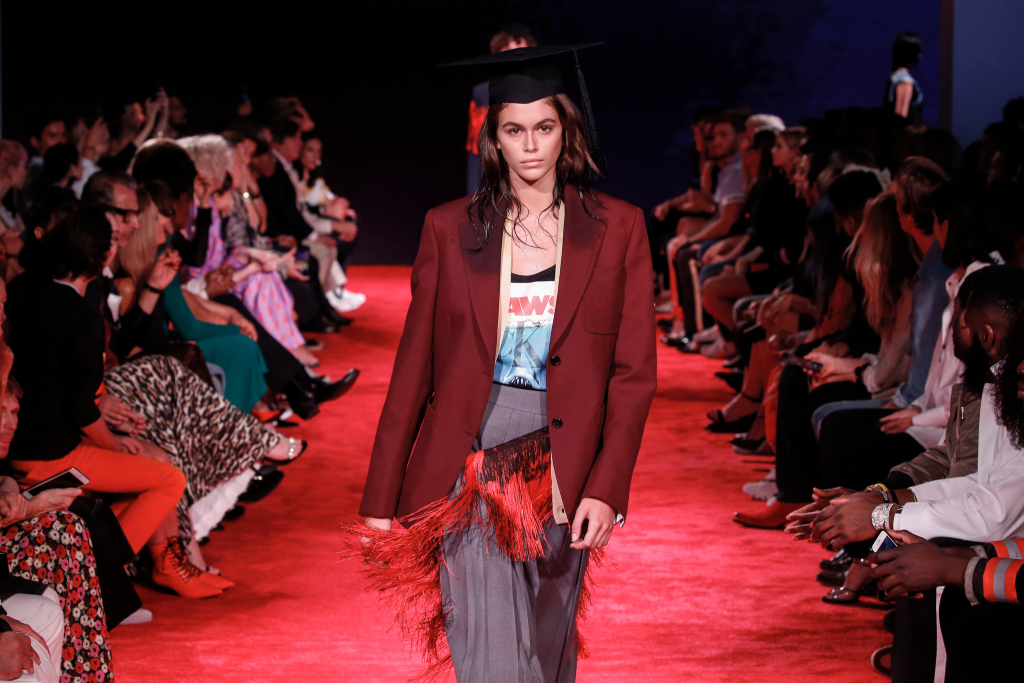New York – Calvin Klein

Raf Simons’ powerful capability to critique the America of our time was again exhibited in his simplistic collection of college kid inspired looks. Tributes were paid to the traditionalism of an Ivy League college, as youthful models walked the runway in preppy outfits composed largely of knitwear and tweed, occasionally accessorised with a mortarboard and graduation robe. Importantly, Simons also chose not to gloss over the epidemic of sexual violence entangled within present day university culture: layered underneath these classic looks models wore scuba pieces of thick, synthetic fabric, which Simons has remarked ‘stand for protection, for sex, for different things.’
Also seen were predatory rips in delicate skirt hems, knitwear which appeared to have been forcefully tugged at, and even prints from the iconic 1975 movie JAWS, all symbolic of vicious sexual assault. Simons’ Calvin Klein is a fantastic example of the politicism of high fashion.
Milan – Marni

A lesser known name in the Milan fashion scene, Francesco Risso’s recent collections for Marni offer a modern take on the extravagant Italian aesthetic primarily established by Versace. Where the latter brand has become somewhat tired, and many would argue tacky, Marni progressively adapts flamboyance for the powerful female client. The Spring/Summer 2019 collection saw power dressing manifested in rounded, inherently feminine shapes, with leather bustiers, jackets and
coats impeccably tailored to viscerally enhance the female frame. These sturdy tops were paired with flouncy skirts and dresses displaying collaged images of Greek statues, an idea that reflected Risso’s recent interest in the metamorphoses between drafts of classical nudes eventually completed in marble. In this collection, Risso is concerned with experimentation, flexibility and cheer; for Marni, a woman does not have to be severe to be respected.
London – Richard Quinn

Though Riccardo Tisci’s Burberry debut was the biggest talking point of London Fashion Week, its unclear brand direction meant that the collection doesn’t make my key shows for this year. Richard Quinn, on the other hand, made a clear statement of his vision for the fashion world by inviting one hundred schoolchildren to his show, as a protest towards government cuts to arts education. Preaching the value of luxury dressmaking, Quinn’s opening shadow looks invited an appreciation for the skill level required to create the beautiful pieces that followed; thirty looks were connected not via polemic, thematic references comparable to Simons’ Calvin Klein, but the sheer beauty of their craftsmanship. All-white beaded gowns comparable to the work of Elie Saab were exhibited alongside full bodied silk dresses that echoed a toned-down version of infamous Valentino Haute Couture, proving the designer’s phenomenal skill that earlier this year granted him the Queen Elizabeth II Award for British Design. Also experimenting with feathering, tailored outerwear and animal prints whilst still maintaining a clear brand image, Quinn’s latest collection has certified his skill. He is a huge name to watch within the British fashion scene.
Paris – Celine

Having explored three collections of empowering female fashion, it is only right to justify their beauty by providing a counter case; unfortunately my final key show highlights the more problematic side of the fashion world. Celine under Phoebe Philo had an understated aesthetic that allowed women to shine through their clothes, not be blanketed by them, and Hedi Slimane’s debut at the brand has utterly abolished this feminist simplicity. Gone are the relaxed tailored trench coats, trouser suits and shift dresses of last year’s spring/summer, and in is a collection primarily composed of little black dresses, most of which are worsened by gaudy sequins and awkward cut-outs. Oversized leather outerwear seemed not to belong to the models, but instead to swamp them with droopy shapes, as if a strange male partner had dumped his jacket on a new female accomplice outside a rather depressing party. A tired palette of black and metallic tones mirrored the tiresome lack of diversity in models, many of which were also worryingly thin, suggesting that Celine is certainly not immune to Slimane’s villainous tendency to revamp formerly uplifting brands in a melancholic wash of black.
By Katherine Corcoran.

